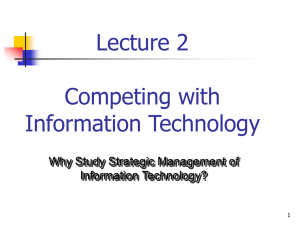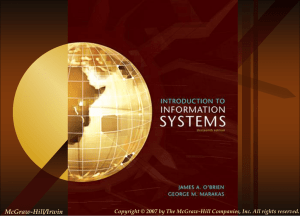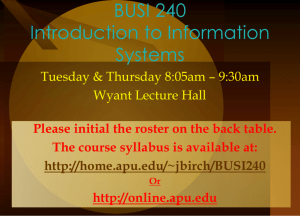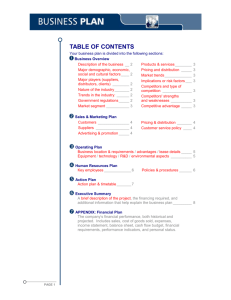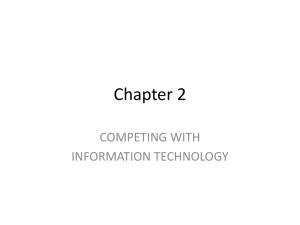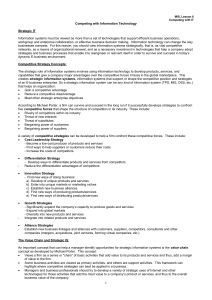Chapter 2 PowerPoint
advertisement
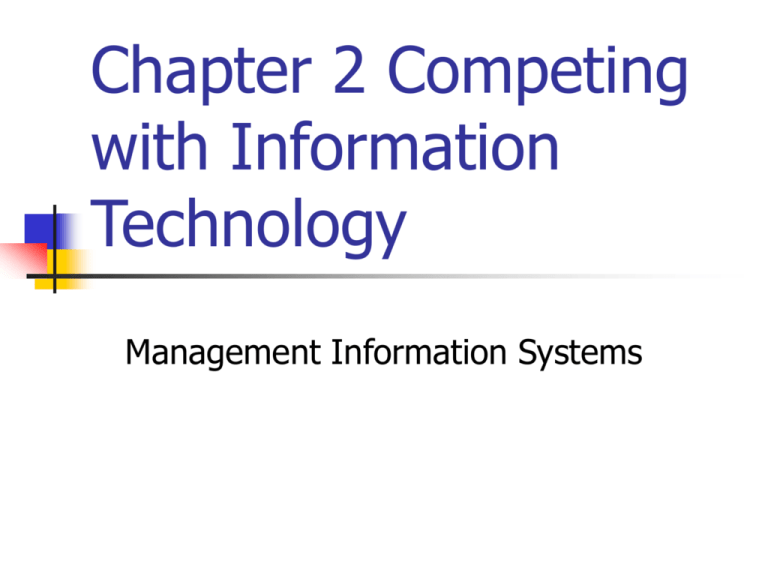
Chapter 2 Competing with Information Technology Management Information Systems Learning Objectives Identify several basic competitive strategies and explain how they can use information technologies to confront the competitive forces faced by a business. Identify several strategic uses of Internet technologies and give examples of how they give competitive advantages to a business. Learning Objectives Give examples of how business process reengineering frequently involves the strategic use of Internet technologies. Identify the business value of using Internet technologies to become an agile competitor or to form a virtual company Explain how knowledge management systems can help a business gain strategic advantages. Why Study Strategic IT? Technology is no longer an afterthought in forming business strategy, but the actual cause and driver. IT can change the way businesses compete. Strategic View of Information Systems Information systems are vital competitive networks. Information systems are a means of organizational renewal. IS are a necessary investment in technologies that help a company adopt strategies and business processes that enable it to reengineer or reinvent itself in order to survive and succeed in today’s dynamic business environment. Case #1: Does IT Matter? Nicholas Carr: It is simply the infrastructure of modern business. It’s equivalent to railroads, electricity, and internal combustion engineering. Once innovative applications of IT have become simply the cost of doing business. Case #1: Does IT Matter? How important is IT to GE? Business imperative Lifeblood for productivity 20% return on technology investments and GE invests $2.5 to $3 billion a year Case #1: Does IT Matter? Nicholas Carr: Today’s main risk is not underusing IT but overspending on it. Case #1: Does IT Matter? Michael Dell, CEO of Dell Computers Anything in business can be either a sinkhole or a competitive advantage if you do it really, really bad or you do it really, really well. You’ve got a lot of people who don’t know what they’re doing and don’t do it very well. Case #1: Does IT Matter? Andy Grove, Chairman of Intel Corp. Commercial-transaction processing in the United States and some parts of Europe has reach maturation but that’s only one segment of IT. What is IT? Case #1: Does IT Matter? A bunch of networks and computers OR Hardware plus the software that mediates and manages human knowledge or information Case #1: Does IT Matter? Charles Fitzgerald, Microsoft General Manager The source of competitive advantage in business is what you do with the information that technology gives you access to. How do you apply that to some particular business problem? Case #1: Does IT Matter? Paul Strassman, former CIO of General Foods, Xerox, Pentagon, and NASA Information technology today is a knowledge-capital issue. Look at the business powers – most of all Wal-Mart, but also companies like Pfizer or FedEx. They’re all waging information warfare. Case #1: Does IT Matter? 1. 2. Do you agree with the argument made by Nick Carr to support his position that IT no longer gives companies a competitive advantage? Why or why not? Do you agree with the argument made by the business leaders in this case in support of the competitive advantage that IT can provide to a business? Why or why not? Case #1: Does IT Matter? 3. 4. 5. What are several ways that IT could provide a competitive advantage to a business? Use some of the companies mentioned in this case as examples. Visit their websites to gather more information to help you answer. What does Mr. Strassman mean by information warfare? Can information technology give a competitive advantage to a small business? Why or why not? Use an example to illustrate your answer. Strategic Information Systems Definition: Any kind of information system that uses information technology to help an organization gain a competitive advantage, reduce a competitive disadvantage, or meet other strategic enterprise objectives. Mission and Competitive Strategies Corporate Mission or Objective Competitive Strategy - Major policies to support the company to compete with other companies so it can survive in the long run Competitive Forces and Strategies Competitive Forces Definition: Shape the structure of competition in its industry. Porter’s Competitive Forces Model To survive and succeed, a business must develop and implement strategies to effectively counter the: Rivalry of competitors within its industry Threat of new entrants into an industry and its markets Threat posed by substitute products which might capture market share Bargaining power of customers Bargaining power of suppliers Competitive Strategy Cost Leadership Strategy Differentiation Strategy Innovation Strategy Growth Strategy Significantly expanding a company’s capacity to produce goods and services Alliance Strategy Cost Leadership Strategy Becoming a low-cost producer of products and services Finding ways to help suppliers and customers reduce their costs Increase costs of competitors Differentiation Strategy Developing ways to differentiate a firm’s products and services from its competitors’ Reduce the differentiation advantages of competitors Innovation Strategy Development of unique products and services Entry into unique markets or market niches Making radical changes to the business processes for producing or distributing products and services that are so different from the way a business has been conducted that they alter the fundamental structure of an industry Growth Strategy Significantly expanding a company’s capacity to produce goods and services Expanding into global markets Diversifying into new products and services Integrating into related products and services Alliance Strategy Establishing new business linkages and alliances with customers, suppliers, competitors, consultants, and other companies Competitive Strategy Examples Other Competitive Strategies Locking in customers or suppliers by building valuable new relationships with them. Building switching costs so a firm’s customers or suppliers are reluctant to pay the costs in time, money, effort, and inconvenience that it would take to switch to a company’s competitors. Other Competitive Strategies Raising barriers to entry that would discourage or delay other companies from entering a market. Leveraging investment in information technology by developing new products and services that would not be possible without a strong IT capability. Advantage vs. Necessity Competitive Advantage – developing products, services, processes, or capabilities that give a company a superior business position relative to its competitors and other competitive forces Competitive Necessity – products, services, processes, or capabilities that are necessary simply to compete and do business in an industry Customer-Focused Business A business that: can anticipate customers’ future needs. responds to customer concerns. provides top-quality customer service. IS in a Customer-Focused Business Value Chain Definition: View of a firm as a series, chain, or network of basic activities that add value to its products and services, and thus add a margin of value both to the firm and its customers. Value Chain Value Chain Case #2: Using IT to tap Expert Know-How U.S. DOC AskMe Knowledge Management System Automated best practices Automated experts’ profile creation Addition of numerous methods for accessing and delivering knowledge Integrated real-time collaborative services Comprehensive analytic capabilities Case #2: Using IT to tap Expert Know-How Benefits Experts’ knowledge is organized Experts’ are more easily contacted Information is reusable saving 750 hours of repetitive work Return on investment is tracked Popular topics are identified so DOC can beef up its expertise in those areas Case #2: Using IT to tap Expert Know-How 1. What are the key business challenges facing companies in supporting their global marketing and expansion efforts? How is the AskMe knowledge management system helping to meet this challenge? Explain. Case #2: Using IT to tap Expert Know-How 2. 3. How can the AskMe system help to identify weaknesses in global business knowledge within the Department of Commerce? What other global trade situations could the AskMe system provide information about? Provide some examples. Case #2: Using IT to tap Expert Know-How 4. Is the AskMe system intended to help the DOC become a knowledgecreating organization? Why or why not? Business Process Reengineering Definition: Fundamental rethinking and radical redesign of business processes to achieve dramatic improvements in cost, quality, speed, and service. Value Chain Analysis - Disintermediation to the Consumer Cost/ Sweate r Manufacturer Manufacturer Manufacturer Distributor Retailer Customer $48.50 Retailer Customer $40.34 Customer $20.45 BPR vs. Business Improvement Stockless Inventory Compared to Traditional and Just-in-time Supply Methods Cross-Functional Processes Agility Definition: The ability of a company to prosper in rapidly changing, continually fragmenting global markets for highquality, high performance, customerconfigured products and services. Agile Company Definition: A company that can make a profit in markets with broad product ranges and short model lifetimes, and can produce orders individually and in arbitrary lot sizes. Becoming an Agile Company Dell Computer – Agility in Action Customer-Focused Company Champion of Mass Customization Build-to-Order Business Model 25,000 on a Typical Day Tight Supply Chain Management Rarely More than Two Hours Worth of Parts Inventory Mass Customization Definition: Providing individualized products while maintaining high volumes of production Agile Competitor Virtual Company Definition: An organization that uses information technology to link people, organizations, assets, and ideas. Inter-enterprise Information Systems Definition: Information systems implemented on an extranet among a company and its suppliers, customers, subcontractors, and competitors with whom it has formed alliances. Virtual Company Strategies Cisco Systems: Virtual Manufacturing Alliances Alliances Create a Virtual Manufacturing Company Three Companies Involved in the Alliance Provides and Agile Build-to-Order Capability in Fiercely Competitive Industry Virtual Company Virtual Company Strategies Share infrastructure and risk with alliance partners. Link complementary core competencies. Reduce concept-to-cash time through sharing. Virtual Company Strategies Increase facilities and market coverage. Gain access to new markets and share market or customer loyalty. Migrate from selling products to selling solutions. Knowledge-Creating Companies Definition: Consistently creating new business knowledge, disseminating it widely throughout the company, and quickly building the new knowledge into their products and services. Types of Knowledge Explicit Knowledge – data, documents, things written down or stored on computers Tacit Knowledge – the “how-tos” of knowledge, which reside in workers Knowledge Management Definition: Techniques, technologies, systems, and rewards for getting employees to share what they know and to make better use of accumulated workplace and enterprise knowledge. Knowledge Management Systems – manage organizational learning and business know-how Levels of Knowledge Management Case #3: Shareware Grows Up How a software cooperative works Companies pay a membership which entitles them to use any of the intellectual property of the co-op. Member companies will donate intellectual property, cooperate in adapting it for other companies, help troubleshoot problems and form subgroups to develop needed niche software for the library. Case #3: Shareware Grows Up Benefits Decrease in the total cost of ownership of software Co-op becomes responsible for assets and also ensure that there’s a clear title so member companies can’t be sued later The larger the installation base, the lower the cost of ongoing maintenance Case #3: Shareware Grows Up Challenge Getting members to really collaborate Case #3: Shareware Grows Up 1. Organizations are constantly striving to achieve competitive advantage, often through their information technologies. Given this constant, why does Hansen suggest that competition among members shouldn’t be an issue because the shared assets don’t bring competitive advantage? Explain. Case #3: Shareware Grows Up 2. 3. What do you see as the potential risks associated with the Avalanche approach? Provide some examples. How could other companies apply the cooperative model used by Avalanche to achieve efficiencies in areas other than software support? Explain. Case #4: Customer-Loyalty Systems Satisfaction vs. Loyalty A satisfied customer is one who sees you as meeting expectations. A loyal customer, on the other hand, wants to do business with you again and will recommend you to others. Case #4: Customer-Loyalty Systems A good loyalty program combines customer feedback and business information with sophisticated analytics to produce actionable results. With good customer loyalty technology, IT can wire the voice of the customer back into the enterprise. Case #4: Customer-Loyalty Systems How can IT help? Gathering customer experience data by email rather than telephone dramatically reduces survey cycle times Can build in validated, multivariate measures of loyalty into the software Software-generated models can accurately predict customer’s purchasing behavior IT can be used to deliver rewards to customers based on predictive analysis Case #4: Customer-Loyalty Systems 1. 2. 3. Does CDW’s customer loyalty program give them a competitive advantage? Why or why not? What is the strategic value of Harrah’s approach to determining and rewarding customer loyalty? What else could CDW and Harrah’s do to truly become a customer-focused businesses? Visit their websites to help you suggest several alternatives. Summary Information technologies can support many competitive strategies including cost leadership, differentiation, innovation, growth and alliance. IT can help Build customer-focused businesses Reengineer business processes Businesses become agile companies Create virtual companies Build knowledge-creating companies
